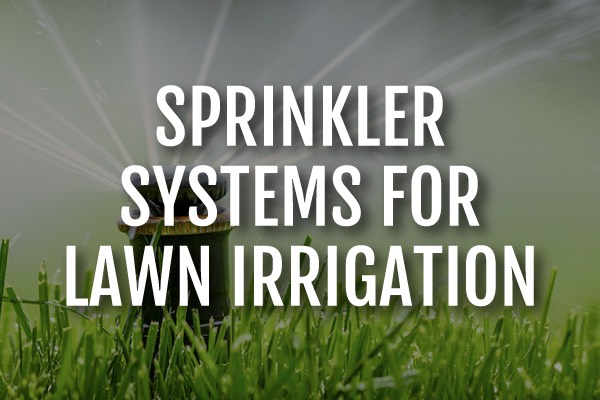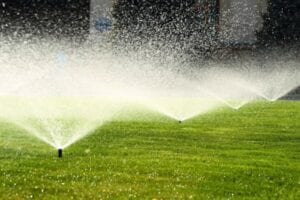
Tired of watering your lawn manually? If so, it may be time to have an irrigation system installed on your property. Before you install a lawn irrigation system, though, there are some essential things you should know.
What is an Irrigation System?
An irrigation system is used to help nurture your landscape by providing the water it needs to keep your plants thriving. Sprinkler irrigation systems are one of the most cost-effective and versatile methods of lawn irrigation.
There are many benefits to having an irrigation system installed on your property. For starters, these systems can save you time and money by providing your lawn with reliable water and coverage when you need it. Regular watering, in turn, helps to keep your landscaping healthy and reduces the need for you to replace plants that have died out due to poor weather conditions.
With an irrigation system, you can create your own watering schedule to ensure that your plants and grass receive water consistently. Meanwhile, if rain is in the forecast, you can shut off your irrigation system to prevent overwatering.
Basic Sprinkler Operation
Before you install an irrigation system on your property, it can be helpful to understand the main components of one of these systems.
1. Sprinkler System Controller
The “brains” behind any sprinkler system is the controller, which is an electronic and computerized unit. The controller uses a timer that tells your system when each set of sprinkler heads needs to be turned on (and for how long it should run). Each sprinkler head is connected to a set of valves that regulate the flow of water to each designated “zone” of your property.
2. Irrigation Valves
The valves themselves are directly connected to the controller and your water system, acting like faucets that can be turned on and off. Valves are responsible for feeding water to your entire sprinkler system. This particular system is made up of undersurface pipes, where the water travels from the valves to the actual sprinkler heads.
3. Sprinkler Heads
Sprinkler heads are the parts of your system that actually spray water onto your grass and plants. There are many different types of sprinkler heads, including:

- Fixed spray heads – These are small sprinkler heads that spray in a fan-shaped pattern of water. Most systems that use fixed spray heads have interchangeable nozzles that determine the pattern of the spray, such as half-circle or full-circle. Typically, spray heads are spaced about 18 feet apart to ensure proper coverage and require anywhere from 20-30 PSI of water pressure for best results.
- Rotary heads – These sprinkler heads operate by rotating streams of water back and forth in circles. This design allows for water to be applied more slowly and is generally best for medium and large lawns, as well as side lawns.
- Shrub heads – These sprinkler heads are mounted above the foliage on risers and come with a special nozzle pattern to aid in flexibility. As the name implies, these heads are ideal for watering planters, shrubs, and other larger plants.
- Pop-up heads – These pop above the grass when activated and then disappear underneath the surface when not in use. These heads provide even water distribution and are ideal for lawns and gardens of all sizes.
- Multiple stream heads – These produce thin streams of water that rotate in an 18-27′ span; this style is great for medium lawns due to its excellent coverage, but many homeowners use them to cover slopes and uneven ground as well.
- Gear-driven – These smooth, quietly operating heads offer adjustable patterns to suit your exact needs.
- Flood/bubbler – This style of sprinkler head produces a flow of water that soaks soil to reach the root zone, dispersing water in an area that is 5 feet wide or less. These heads are most often used near tree wells and planters.
Other Considerations for Sprinkler Systems
1. Water Pressure
Too much pressure from your irrigation system can damage your plants and ruin your yard, whereas a lack of pressure may make it difficult for water to reach your plants as needed. Sprinkler systems have to be regulated carefully to ensure that they are giving the right amount of pressure, and all sprinkler heads should have markings that tell how much PSI they can handle to ensure that the pumps are not overpowered.

2. Irrigation Zoning
Setting up irrigation zones throughout your landscape can ensure that different types of plants or areas of your landscape get exactly the right amount of water. Irrigation zones can also cut down on water usage and thus save you money on your water bills.
3. Sprinkler System Installation
Choosing an experienced and certified plumber to install your irrigation system is a must. Oftentimes, individuals who work for a hardware store will offer to install a sprinkler system for you but don’t know much about your outdoor plumbing. Unfortunately, this can lead to improper installation and costly problems down the road.
At HEB Plumbing & Sprinkler, our certified plumbers have the experience and knowledge needed to properly install and service your Arlington, Texas irrigation system, thus saving you trouble and money in the long run. Contact us today to learn more!
